NOBODY'S (*Everybody's!) FASHION WEEK STREETWARE SAVED ITEM DESIGN AS COMMON GOOD WAREHOUSE
ADDRESS JOURNAL
→ Performative Processes
→ New Mentorship
→ Archivist-Creators
→ Alternative Fashion Media
→ Future Fashion Education
→ Mended Scars
→ Second Life
→ Fast Fashion Disruption
BLOOMSBURY FASHION CENTRAL
SEARCHING FOR THE NEW LUXURY
Out of the Shadows: Are we there yet?, 2021 →
Embedded Research, in progress, 2021 →
Speculative Citizen Design, 2020/21
A Magazine Reader and the rise of the Unglossies, 2020
Fashion from the Shadows Series, 2017-2019
ADDRESS Journal for Fashion Criticism, 13.01.2019
ADDRESS Journal for Fashion Criticism, 14.08.2018
ADDRESS Journal for Fashion Criticism, 25.02.2018
ADDRESS Journal for Fashion Criticism, 14.11.2017
ADDRESS Journal for Fashion Criticism, 12.09.2017
ADDRESS Journal for Fashion Criticism, 20.07.2017
ADDRESS Journal for Fashion Criticism, 26.06.2017
ADDRESS Journal for Fashion Criticism, 24.05.2017
Designer Biographies, 2018 →
Authentic Fashion Products!, 2018
ADDRESS Journal for Fashion Criticism, 24.05.2017 [*]
 Public intervention by Craftivist Collective
Public intervention by Craftivist Collective
‘An increasingly narrow spectrum of activity is valued, and what we demand today is more and more conditioned by prior experiences of individualistic consumption. Alternatives are forced out of the mainstream and into the shadows, and ultimately suppressed.’
Kate Fletcher (2014)
ETHOS
Fast Fashion Disruption seeks to raise awareness of the fast fashion industry’s unethical mechanisms by manipulating and subverting its products and/or by taking performative action in and outside of the shops in which they are sold. The methods synonymous with this approach are informed by a vision for the future fashion industry that promotes ethical consumption, fair trade and social equality.
Fast Fashion Disruption is deeply rooted in an interest in the inner workings of the fashion system as well as in the urge to change it. This is attempted by either challenging it directly or by pointing out existing problems. The main aims of this movement are to increase public awareness of production conditions, to decrease consumption, to promote transparency and to pressure fast fashion brands to take responsibility for the well-being of their employees. In addition to this, the movement seeks to maintain the independence of fashion’s creative force and to end exploitation on all levels of the fashion system. Underneath this is the belief that fixing fast fashion will lead to a more just fashion industry where equally distributed power is promoted over a centralized corporate power.
Fast Fashion Disruption is already helping to change the industry. As a result, some fast fashion brands are issuing statements outlining their ethical responsibility, responding to concerns raised by the public, starting to raise worker’s wages and publishing more thorough reports about the production and provenance of the products they make. While the truthfulness of the statements remain questionable, these efforts are the first step towards a more sustainable future for one of the planet’s most harmful industries.
KEY TACTICS
Culture Jamming, Fashion Hacking, Informing, Subverting, Reframing, Stealing, Infiltration
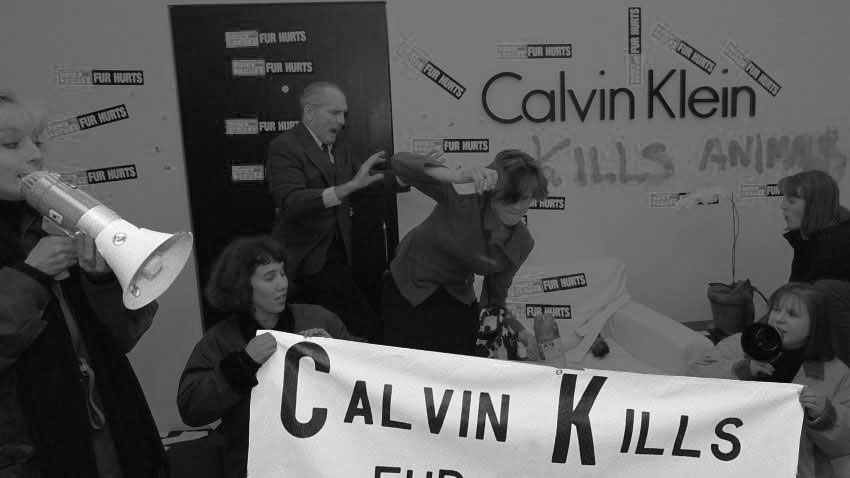
CONTEXT
The main ideas that shape Fast Fashion Disruption originated outside of the fashion industry. They evolved from protest movements by environmental and human rights activists, targeting fashion brands that engaged in unethical activities such as child labour, use of hazardous chemicals and animal cruelty.
A leader in this has been Peta, the animal rights organization founded in 1980 and known for its 'Rather Go Naked than Wear Fur' campaign involving celebrity supporters. In preparing the ground for this campaign, the organization occupied Calvin Klein’s New York office to oppose the label’s use of fur in 1994, succeeding in ending it shortly after. Peta supporters are known to stage anti-fur-protests during the biannual fashion weeks and to launch individual paint-attacks on those who wear fur.
Greenpeace has been challenging fashion to take account of its effects on the environment. In 2011, the organization launched 'Detox my Fashion', a campaign that aims to put pressure on fashion brands that use hazardous chemicals in textile production.

Instead of directly attacking fashion brands, UNICEF has been cultivating close ties with designers and luxury fashion houses, who regularly host charity events for the organization and contribute large donations. The money collected is, among others, directed towards campaigns against child labour in the fashion supply chain. UNICEF sponsors newspaper articles about the issue and sends observation teams for on-site investigation with the International Labor Organization.
Recently, Fast Fashion Disruption movement has gained momentum in response to the Rana Plaza factory collapse in Bangladesh in 2013. This tragic event resulted in greater consumer awareness of fast fashion’s production conditions that in turn led to increased calls for action, including awareness campaigns, street protests, and independent guerilla activities. The significant difference between the actions before and after Rana Plaza is a shift from outside attacks towards attempts to fix the fashion system from within.
CASE STUDIES
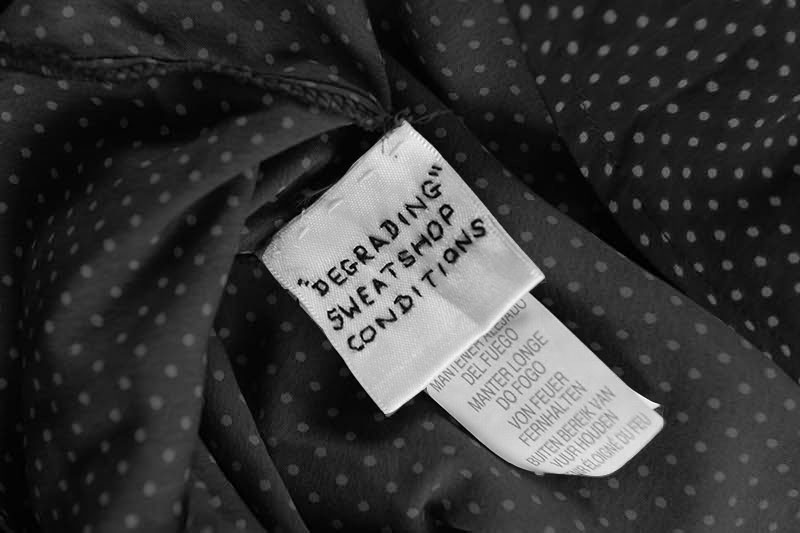
– One of the most mediatized actions following the Rana Plaza factory collapse was a series of hand-stitched labels sewn into Primark garments in 2013. Discovered by shoppers, the labels were inscribed with ‘cries for help’ supposedly embroidered by factory workers. Whilst it turned out that these labels had been later added to the garments in the UK, they nevertheless helped to draw more attention to the issue whilst acting as a critique against Primark that used the Rana Plaza factory for manufacturing its products. This provocation echoes the approach taken by the Craftivist Collective founded by Sarah Corbett in 2009. The group uses craft for ‘gentle protest’ and as a point of critical reflection on global issues. Both of these examples demonstrate how a small individual disruptive action can have a big, lasting impact on the system.
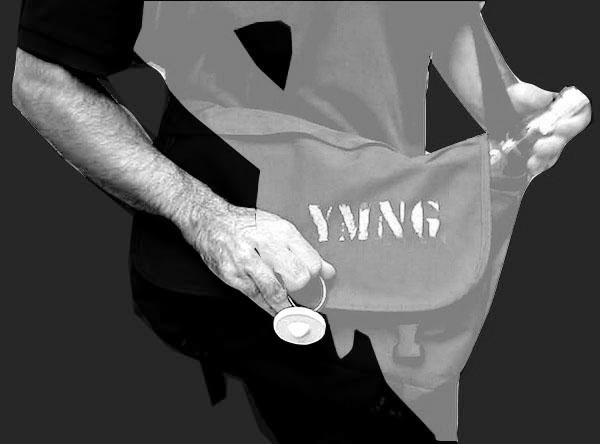
– Yomango is a movement that originated in Spain in 2002. The name is derived from the fast fashion chain Mango, translating from Spanish into ‘I steal’. This approach has been applied in different ways to challenge fast fashion. Yomango celebrates stealing — not from people, but from large transnational corporations that are accused of showing no respect for workers’ rights or the environment. To facilitate taking action, Yomango activists have designed multi-pocketed accessories and suggested clothing hacks. The stealing is complemented by performative protests like ‘fashion shows’ with stolen clothing, publications and press releases. In many cases, Yomango’s actions have been supported or directly fostered by employees of these large companies, some of whom have become active members of the group, turning Yomango into an undercover protest from within.
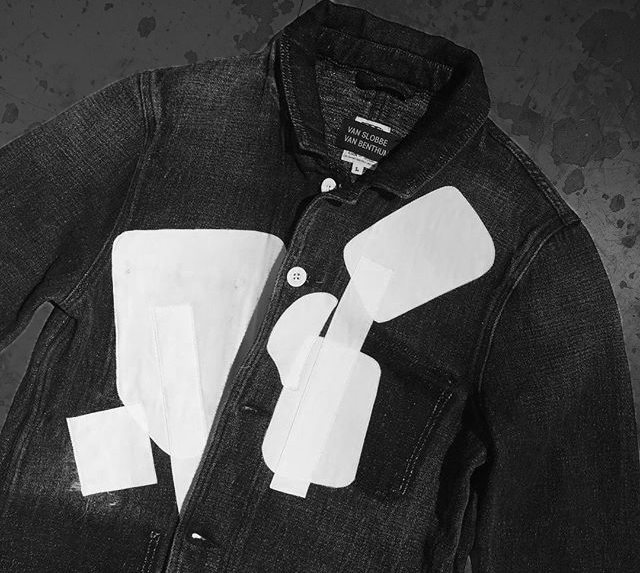
– Hacked by Van Slobbe Van Benthum seeks to target fashion audiences in a more traditional way by presenting contemporary fashion collections. Instead of creating new designs from scratch, the label presents unsold stock from fast fashion factories that have been modified by the Dutch designer duo. In doing so, Alexander van Slobbe and Francisco van Benthum appropriate fast fashion garments turning them into their own designs. With minimal alterations, they reverse the process of fast fashion brands copying designer’s work whilst reclaim their independence.

– In 2017, streetwear designer Warren Lotas distributed unauthorized t-shirts in front of one of the H&M stores in Los Angeles. In a similar vein as Hacked by Van Slobbe Van Benthum, Warren Lotas’ work is driven by an idea of revenge that is expressed through subverting and reframing brand logos. The underlying message is: if the corporations steal from small designers, the small designers will steal back.

– Taking on the role of a whistleblower, Clean Clothes Campaign regularly initiates street protests in front of shops of brands that are behind on paying workers. This method creates awareness and news coverage. While the aim is not to prevent customers from entering shops, the campaign does dissuade some by bringing issues to public attention.
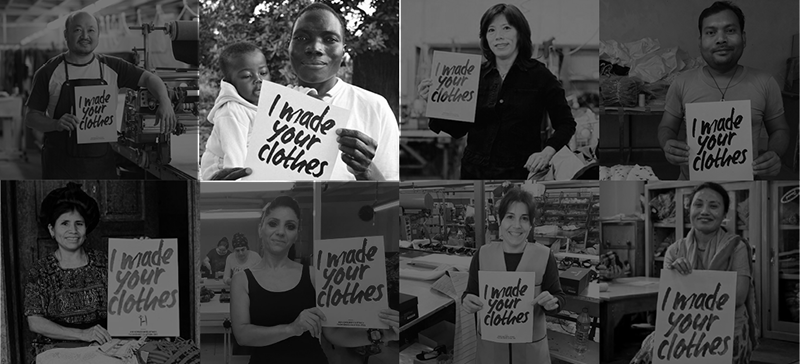
– Fashion Revolution initiates campaigns on social media and takes the discussion offline by setting up repair cafés and swishing events. The organization seeks to engage with younger audiences though the use of hashtags such as #whomademyclothes and #haulternative. With a commercial visual language and collaborations with fashion bloggers, Fashion Revolution has the power to attract shopping enthusiasts and convert them into conscious consumers.
→
Gathering common motivations that unite a broad range of practitioners, ‘FASHION FROM THE SHADOWS’ -series aims to map alternative approaches to thinking, creating, presenting and discussing fashion. It provides an overview of recent developments in the discipline in order to integrate them into a new and more inclusive fashion system that encourages discussion. Instead of being suppressed, these alternatives broaden fashion’s spectrum of activities and help to provide a more complete understanding of the spirit of the time which fashion has always sought to reflect.